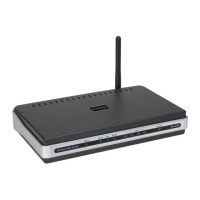Web Configuration
D-Link DSL-2640B User Manual 78
QoS
Many communication and multimedia applications require large, high-speed
bandwidths to transfer data between the local network and the internet. However,
for many applications there is often only one internet connection available with
limited capacity. QoS divides this capacity between the different applications and
provides undelayed, continuous data transfer in situation where data packets with
higher priority are given preference.
Network QoS is an industry-wide set of standards and mechanisms for ensuring
high-quality performance for critical applications. By using QoS mechanisms,
network administrators can use existing resources efficiently and ensure the
required level of service without reactively expanding or over-provisioning their
networks.
Traditionally, the concept of quality in networks meant that all network traffic was
treated equally. The result was that all network traffic received the network’s best
effort, with no guarantees for reliability, delay, variation in delay, or other
performance characteristics. With best-effort delivery service, however, a single
bandwidth-intensive application can result in poor or unacceptable performance for
all applications. The QoS concept of quality is one in which the requirements of
some applications and users are more critical than others, which means that some
traffic needs preferential treatment.

